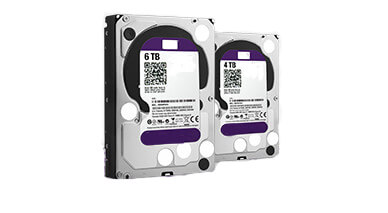IP Surveillance Systems – IP Video Storage
The migration from analog to digital has been on the rise for several years and thanks to new computer technologies, video over IP is more prevalent today. With the expansion of surveillance technologies, companies have enjoyed the benefits of IP surveillance systems because they are great investments that have both functional and financial benefits. IP surveillance systems are also cost-effective with a high return on investment (ROI); they provide superior image quality and can be accessed remotely.
To help you choose the best option for your business, we’ve examined some common IP video recording solutions:
1) IP Camera with Embedded Storage
Some IP cameras offer a SD card slot that allows users to install a memory card for storing video or image snapshots, which is convenient for those who want to have an alternative backup. This type of solution, also known as an edge recording solution, secures the recording footage at the camera site, especially when a connection issue occurs between camera and the viewing location (whoever sees it and manages it on the other end). There is still a video in it, which can be retrieved when the connection gets back online.
The downside is that the performance may not be as good as expected, not to mention the limited amount of video that is stored due to the fairly small size of SD card storage available in the market today. If you have more than one IP camera, management and access to video footage is difficult because you must access the cameras one by one.
2) VMS or CMS
Another way to record videos is through PC-based VMS (video management software) or CMS (central management software). A VMS or CMS has the capability to integrate with all kinds of video analytic components, such as people counting, bag detection and license plate recognition. In order to meet your surveillance requirements, you will need a powerful computer or server and a large amount of storage with hundreds of terabytes. Therefore, this type of solution is good for large-scale and heavier surveillance requirements. It may include airports, train stations and enterprises. These not only cost a lot more, but also require a group of trained people to operate, maintain and upgrade when expansion is necessary.
3) Cloud Recording
While cloud computing makes it easy to access anything from anywhere, it is not a practical solution for video surveillance today. Video surveillance requires a large amount of storage capacity and traffic, and a lot of bandwidth for recording videos and browsing. The higher the resolution of video with a higher frame rate, the more bandwidth it requires, and since cloud services charge by usage, it may involve high monthly costs. Therefore, cloud recording is more suitable for event/alarm recording, or for a lower resolution recording that requires less bandwidth.
4) Standalone NVRs
The standalone NVR (Network Video Recorder) is a recording solution that provides a little bit of everything, is easy to manage, affordable and ideal for small and medium-sized businesses. While it does not require special training, it requires some basic network knowledge to setup and configure properly. There are also many online guides that can help with configuration and setup. Furthermore, a standalone NVR can be accessed through Internet Explorer, is high quality and can support four to eight cameras. It has the added benefit of built-in storage, so if network communications are severed or interrupted, surveillance recording will continue without data loss or interruption. If you plan on expanding your surveillance application in the near future, this kind of solution may not be the right fit, especially if you are going to adopt video analytics or integrate with others (like Point of Sale/POS).
IP surveillance used to be complicated and faced limitations because of network infrastructures that were lacking in bandwidth and not ready for it. But today, with new technologies that simplify installation and greater network bandwidth, it is expanding, improving and affordable. Set realistic expectations and look for a system that meets your current surveillance requirements. Chasing an advanced feature may not always be the right thing for your business.
Article Provided By Security Magazine
![]()
If you would like liquidvideotechnologies.com to discuss developing your Home Security System, Networking, Access Control, Fire, IT consultant or PCI Compliance, please do not hesitate to call us at 864-859-9848 or you can email us at deveren@liquidvideotechnologies.com


Recent Comments